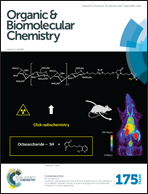Synthesis and anti-tubercular activity of N2-arylbenzo[g]isoquinoline-5,10-dione-3-iminium bromides†
Abstract
Tuberculosis has remained a challenge for medicinal chemists worldwide. In the framework of a collaborative program to identify and evaluate novel antitubercular candidate compounds, the biological properties of benzo[g]isoquinoline-5,10-diones have been found to be very promising. In this paper we have further expanded the library by incorporation of an amidinium moiety into the benzo[g]isoquinoline-5,10-dione scaffold. The presence of this functional group also increased the solubility of the quinones in polar solvents. To this purpose N2-arylbenzo[g]isoquinoline-5,10-dione-3-iminium bromides were synthesized in a straightforward way by means of a reaction of anilines with 2-(bromomethyl)-3-(cyanomethyl)-1,4-dimethoxynaphthalene. Following the biological evaluation, N2-(4-chlorophenyl)-5,10-dioxobenzo[g]isoquinoline-3(2H)-iminium bromide (MIC = 1.16 μM, CC50 = 28.51 μM, SI = 24.58) was selected as the most promising representative. Apart from the nano-molar anti-mycobacterial activity, the compound was able to target intracellular residing Mycobacterium tuberculosis and the susceptibility of a multi-drug-resistant strain towards the compound was confirmed.
![Graphical abstract: Synthesis and anti-tubercular activity of N2-arylbenzo[g]isoquinoline-5,10-dione-3-iminium bromides](/en/Image/Get?imageInfo.ImageType=GA&imageInfo.ImageIdentifier.ManuscriptID=C5OB02138C&imageInfo.ImageIdentifier.Year=2016)

 Please wait while we load your content...
Please wait while we load your content...